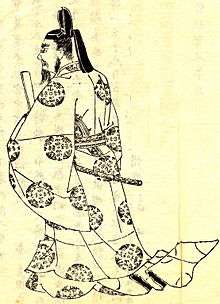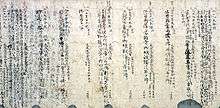Fujiwara no Michinaga

Fujiwara no Michinaga (藤原 道長, 966 – January 3, 1028) represents the highpoint of the Fujiwara clan's control over the government of Japan.
Early life
He was the fourth or fifth son of Fujiwara no Kaneie by his wife Tokihime, daughter of Fujiwara no Nakamasa. There were two regents and two imperial consorts among his brothers and sisters by the same mother.
As the youngest son of his father, he was not remarkable in the court until his two brothers died. He started his career in the court when he was 15 years old.
- 986 (Kanna 2): Sakyō no Daibu (左京大夫)
- 986 (Eien 2, 29th day of the 1st month) : Gon-no-Chūnagon (権中納言)
- 991 (Shōryaku 2, 7th day of the 9th month): Gon-no-Dainagon (権大納言)
In 995 during the reign of Emperor Ichijō, his two elder brothers Michitaka and Michikane died of disease. He struggled with Fujiwara no Korechika, the elder son of Michitaka, for political power. With support of Senshi, his sister and mother of Ichijō, Michinaga succeeded in gaining power as well the support of majority of the court. He was appointed Nairan, the secretary of the emperor and the reviewer of all the documents sent to the emperor before the emperor himself read them.
Career
Michinaga exerted de facto reign over Japan in the early 11th century. This can be seen from the fact that he was father to four (non-reigning) empresses, uncle to two emperors and grandfather to another three.
- 995 (Chōtoku 1, 19th day of the 6th month): Udaijin (右大臣)
- 996 (Chōtoku 2, 20th day of the 7th month): Sadaijin (左大臣)[1]
Though Ichijō already had an empress, a daughter of Michitaka, he claimed there were two types of empresshood and therefore it was legal for an emperor to have two empresses at the same time. Michinaga's ambitions led him to make his own daughter, Shōshi, a second empress of Ichijō. In 1000 Shōshi was announced as a Chūgū empress and the existing empress Teishi was given the title of Kōgō empress. It was the first time an emperor had two empresses. A power struggle between Korechika and Michinaga continued until Teishi's unexpected death in 1001, which sealed Michinaga's power since Shōshi became the only empress after Teishi's death.
In 1006, Michinaga invited Murasaki Shikibu to become Empress Shōshi’s companion and tutor.[2]
Shōshi was the mother of two princes who became emperors: Emperor Go-Ichijō and Emperor Go-Suzaku. Michinaga's other daughters, Kenshi and Ishi, followed similar fates to Shōshi and further ensured Michinaga's power over the court.
- 1011 (Kankō 8, 13th day of the 6th month): In the 25th year of Emperor Ichijō's reign (一条天皇25年), the emperor abdicated; and the succession (‘‘senso’’) was received by his cousin. Shortly thereafter, Emperor Sanjō is said to have acceded to the throne (‘‘sokui’’).[3]
After Ichijō retired because of illness, Emperor Sanjō ascended the throne. Though Sanjō was a nephew of Michinaga (the mother of Sanjō was another sister of Michinaga; she had died already in Sanjō's childhood and he was relatively less influenced by his maternal line).
- 1011 (Kankō 8): Michinaga is Sesshō [4]
- 1011 (Kankō 8, 23rd day of the 8th month): Fujiwara Michinaga is granted the extraordinary privilege of travelling to and from the court by ox-drawn cart.[5]
Michinaga and Sanjō's opinions often varied. Michinaga pressured Sanjō to retire and finally Sanjō did so in 1016 under a condition made upon Sanjō's succession. Sanjō's elder son was appointed as Go-Ichijō's successor.
- 1011 (Kankō 8): Prince Atsunari, the second son of former-Emperor Ichijo, is proclaimed Crown Prince.[6] Sanjō's eldest son, Prince Atsuakira, had been the officially designated heir, but pressure from Michinaga forced the young prince to abandon his position.[7]
Michinaga's political power and influence led to the crown prince's resignation by his will. Michinaga was pleased by this decision and gave his daughter (either Kenshi or Ishi) to this prince as a wife, ensuring that the prince would not be an obstacle in the future.
- 1012 (Chōwa 1, 8th month): Emperor Sanjō marries a daughter of Sesshō and later Kampaku Fujiwara no Michinaga.[8]
During the initial years of Go-Ichijō's reign, Fujiwara no Michinaga actually ruled from his position as sesshō (regent).[9] Although Michinaga never formally took on the title of kampaku regent, he exercised great power and influence.
- 1013 (Chōwa 2, 9th month): Sanjō visits the home of Michinaga.[10]
- 1013 (Chōwa 3, 5th month): Sanjō visited the home of Michinaga where he enjoyed himself with horse riding and archery.[10]
- 1015 (Chōwa 4, 10th month): Michinaga's 50th birthday is celebrated.[10]
- 1016 (Chōwa 5, 29th day of the 1st month): Michinaga is Sesshō for Emperor Go-Ichijō
- 1017 (Chōwa 6, 16th day of the 3rd month): retired from Sesshō
- 1017 (Kannin 1, 8th month): Prince Atsuakira, the eldest son of Emperor Sanjo, had been named Crown Prince, but after he is struck by a skin disease and under intense pressure from Michinaga; he withdraws from this role and his younger brother, Prince Atsunaga, is named Crown Prince in his place.[11]
- 1017 (Kannin 1, 9th month): Michinaga made a pilgrimage to the Iwashimizu Shrine accompanied by many courtiers. The travelers divided themselves amongst 15 boats for a floating trip down the Yotogawa River. One of the vessels overturned, and more than 30 people lost their lives.[12]
- 1017 (Kannin 1, 4th day of the 12th month): Michinaga was elevated to the office of Daijō Daijin.[12]
- 1018 (Kannin 2, 9th day of the 2nd month): retires from Daijō Daijin
- 1019 (Kannin 3, 21st day of the 3rd month): Becomes a priest.
Later years
Michinaga exercised such powers even after he formally retired from public life in 1019. He continued to direct the affairs of his son and successor, Fujiwara no Yorimichi.
Michinaga is popularly known as the Mido Kampaku, implying that he had usurped the full power of a kampaku without necessarily calling himself that, though he retained the title sesshō regent in a short term from 1016 till 1017. In 1017, he gave this office to his heir Yorimichi. Soon afterwards, a series of emperors started to retire to a monastery early in life, and put their young sons on the throne to run the country from behind the scenes. As it turned out, this tactic briefly allowed the emperors to wrestle power back from the Fujiwara clan, only to see it fall to the Taira warrior clan instead.
Death
- January 3, 1028 (Manju 4, 4th day of the 12th month): Michinaga died at the age of 62.

Legacy
Michinaga left a diary, Midō Kanpakuki, that is one of the prime sources of information about Heian-era court life at its height.
Self-evaluation
"This world, I think,
Is indeed my world.
Like the full moon I shine,
Uncovered by any cloud"
This poem is known as Mochizuki no Uta (望月の歌) (Full Moon Poem). In 1018, his daughter Ishi became Empress (Chūgū) of Emperor Go-Ichijō, Kenshi became Empress Dowager (Kōtaigō), and Shōshi was Grand Empress Dowager (Tai-Kōtaigō). Three of his daughters became Empresses. Furthermore, both Emperor Go-Ichijō and Crown Prince Atsunaga were his grandsons. This poem was composed at the party to celebrate his daughter's accession. He expressed his delight to win power in this poem.
Genealogy

He was married to Minamoto no Rinshi/Michiko (源倫子), daughter of Sadaijin Minamoto no Masanobu. They had six children.
- Shōshi (彰子) (Jōtōmon-in, 上東門院) (988-1074) - consort of Emperor Ichijō
- Yorimichi (頼通) (992-1074) - regent for Emperor Go-Ichijō, Emperor Go-Suzaku, and Emperor Go-Reizei
- Kenshi (妍子) (994-1027) - consort of Emperor Sanjō[4]
- Norimichi (教通) (996-1075) - regent for Emperor Go-Sanjō and Emperor Shirakawa
- Ishi (威子) (999-1036) - consort of Emperor Go-Ichijō[4]
- Kishi (嬉子) (1007-1025) - consort of Crown Prince Atsunaga (later Emperor Go-Suzaku)
He was also married to Minamoto no Meishi (源明子), daughter of Sadaijin Minamoto no Takaakira. They had six children.
- Yorimune (頼宗) (993-1065) - Udaijin
- Akinobu (顕信) (994-1027) - He became a priest at the age of 19.
- Yoshinobu (能信) (995-1065) - Gon-no-Dainagon
- Kanshi (寛子) (999-1025) - consort of Imperial Prince Atsuakira (Ko-Ichijō-in)
- Sonshi (尊子) (1003?-1087?) - married to Minamoto no Morofusa
- Nagaie (長家) (1005-1064) - Gon-no-Dainagon
Michinaga had one daughter from an unknown woman.
- Seishi (盛子) (?-?) - married to Emperor Sanjō[4]
See also
Notes
- ↑ Brown, Delmer et al. (1979). Gukanshō, p. 304.
- ↑ Michelle Green, "Kyoto Celebrates a 1,000-Year Love Affair", New York Times, January 4, 2009.
- ↑ Brown, p. 307; Varley, H. Paul. (1980). Jinnō Shōtōki, p. 44; Titsingh, Isaac. (1834). Annales des empereurs du japon, p. 154., p. 154, at Google Books
- 1 2 3 4 Ponsonby-Fane, Richard. (1959). The Imperial House of Japan, p. 15.
- ↑ Brown, p. 307.
- ↑ Brown, p. 308.
- ↑ Ponsonby-Fane, p. 74.
- ↑ Titsingh, p. 154.
- ↑ Brown, pp. 308-309; Varley, p. 195.
- 1 2 3 Titsingh, p. 155.
- ↑ Titsingh, p. 156.
- 1 2 Titsingh, p. 157.
References
- Brown, Delmer M. and Ichirō Ishida, eds. (1979). Gukanshō: The Future and the Past. Berkeley: University of California Press. ISBN 978-0-520-03460-0; OCLC 251325323
- Hioki, S. (1990). Nihon Keifu Sōran. Kodansya. (Japanese)
- Kasai, M. (1991). Kugyō Bunin Nenpyō. Yamakawa Shuppan-sha. (Japanese)
- Owada, T. et al. (2003). Nihonshi Shoka Keizu Jimmei Jiten. Kodansya. (Japanese)
- Ponsonby-Fane, Richard Arthur Brabazon. (1959). The Imperial House of Japan. Kyoto: Ponsonby Memorial Society. OCLC 194887
- Titsingh, Isaac. (1834). Nihon Odai Ichiran; ou, Annales des empereurs du Japon. Paris: Royal Asiatic Society, Oriental Translation Fund of Great Britain and Ireland. OCLC 5850691
- Tsuchida, N. (1973). Nihon no Rekishi No.5. Chūō Kōron Sha.
- Varley, H. Paul. (1980). Jinnō Shōtōki: A Chronicle of Gods and Sovereigns. New York: Columbia University Press. ISBN 978-0-231-04940-5; OCLC 59145842